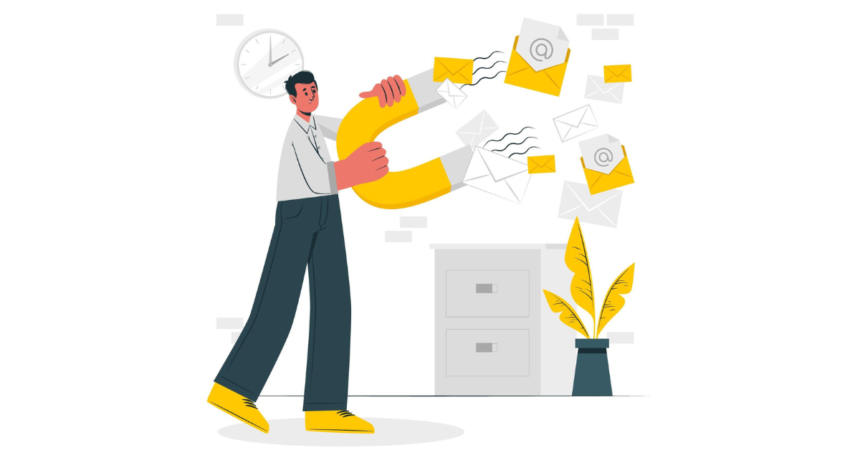
Dayapreetwan Singh
- July 23, 2024
- 15 min read
- Email Marketing
- Blog
I. Introduction
II. Importance of Email Segmentation in Modern Marketing
III. Types of Email Segmentation
IV. Creating Segmented Email Campaigns
V. Implementing Email Segmentation Strategies
VI. Analyzing and Measuring Segmentation Success
VII. Conclusion
I. Introduction
Understanding Email Segmentation
In today’s digital age, email marketing remains a powerful tool for businesses to connect with their audience. However, the effectiveness of email campaigns can be significantly enhanced through a strategy known as email segmentation. This technique involves dividing an email list into smaller, more targeted groups based on specific criteria. By doing so, marketers can tailor their messages to better align with the interests and needs of each segment, leading to higher engagement and conversion rates.
Definition of Email Segmentation
Email segmentation is the practice of splitting your email subscriber list into distinct groups or segments based on predefined criteria. These criteria can include demographics, purchasing behavior, past interactions with emails, and more. The goal of segmentation is to send more personalized and relevant emails to each group, thereby improving the overall performance of email marketing campaigns
II. Importance of Email Segmentation in Modern Marketing
Personalization and Relevance
In the era of information overload, consumers are bombarded with countless marketing messages daily. To stand out, marketers need to deliver content that resonates with individual recipients. Email segmentation allows businesses to do just that by creating personalized and relevant messages tailored to specific audience segments. When emails are customized to reflect the interests, behaviors, and preferences of different groups, recipients are more likely to open, read, and engage with the content. This level of personalization fosters a stronger connection between the brand and the consumer, enhancing the overall effectiveness of targeted email marketing campaigns.
Enhanced Customer Engagement
Engagement is a crucial metric in email marketing, and segmented email campaigns are proven to boost customer engagement significantly. By delivering targeted messages that address the unique needs and pain points of various segments, marketers can capture the attention of their audience more effectively. Segmented emails often result in higher open rates, click-through rates, and conversion rates compared to non-segmented campaigns. This increased engagement not only drives immediate sales but also builds long-term relationships with customers, encouraging loyalty and repeat business.
Improved ROI on Email Campaigns
One of the primary goals of any marketing strategy is to achieve a high return on investment (ROI). Email segmentation plays a vital role in maximizing the ROI of email campaigns. By sending tailored messages to specific segments, businesses can ensure that their marketing efforts are more efficient and effective. Segmented campaigns tend to have higher engagement and conversion rates, leading to better overall performance and a greater return on marketing spend. Moreover, segmentation helps in reducing unsubscribe rates, as recipients receive content that is relevant to their interests, further optimizing the ROI of email marketing initiatives.
III. Types of Email Segmentation
Demographic Segmentation
Age, Gender, Income, Education Level
Demographic segmentation involves categorizing your email list based on basic demographic information such as age, gender, income, and education level. This type of segmentation allows marketers to tailor their messages to meet the specific needs and preferences of different demographic groups. For example, younger audiences might respond better to emails with trendy, visually engaging content, while older demographics might prefer more straightforward, information-rich messages.
Geographic Segmentation
Location-Based Targeting
Geographic segmentation divides your email list according to the physical locations of your subscribers. This could be at the level of countries, states, cities, or even neighborhoods. Location-based targeting is especially useful for businesses with region-specific products or services, such as local events, store openings, or region-specific promotions. Tailoring content to match local interests, culture, and language can significantly increase the relevance and effectiveness of your email campaigns.
Time Zone Considerations
Time zone segmentation ensures that your emails are sent at optimal times for recipients in different geographic locations. Sending an email at 9 AM local time in New York means it will be received at 6 AM in Los Angeles, potentially missing the recipient’s prime email-checking time. By scheduling emails based on the recipient’s time zone, you increase the likelihood of your message being seen and engaged with promptly.
Behavioral Segmentation
Purchase History, Email Engagement, Website Activity
Behavioral segmentation is based on the actions and behaviors of your subscribers. This includes their purchase history, how they engage with your emails, and their activity on your website. By analyzing these behaviors, you can create highly targeted campaigns. For instance, customers who have previously purchased a particular product might be interested in similar items or complementary products. Additionally, understanding which emails are opened and clicked on allows you to refine your messaging to better capture interest and drive further engagement.
Psychographic Segmentation
Interests, Values, Lifestyle
Psychographic segmentation goes deeper by categorizing your audience based on their interests, values, and lifestyle choices. This type of segmentation helps in creating more emotionally resonant and engaging content. For example, a fitness brand might segment their audience into groups interested in yoga, weightlifting, or running, and send tailored content that aligns with each group’s specific interests and motivations. Understanding the underlying values and lifestyles of your audience allows for more authentic and compelling communication.
Lifecycle Stage Segmentation
New Subscribers, Loyal Customers, Inactive Subscribers
Lifecycle stage segmentation involves grouping your audience based on where they are in their customer journey. New subscribers might receive a welcome series of emails to introduce them to your brand and products. Loyal customers, on the other hand, might be targeted with exclusive offers and rewards programs to maintain their loyalty. Inactive subscribers could be re-engaged with special promotions or content aimed at rekindling their interest.
Firmographic Segmentation (B2B)
Industry, Company Size, Job Role
For B2B email marketing, firmographic segmentation is essential. This involves categorizing your email list based on company-related attributes such as industry, company size, and job role. Understanding these factors allows you to tailor your messaging to address the specific challenges and needs of different types of businesses. For instance, the needs of a small startup in the tech industry will differ significantly from those of a large, established corporation in the manufacturing sector. By targeting the right decision-makers within these companies, such as CEOs, marketing managers, or IT directors, you can enhance the relevance and impact of your email campaigns.
IV. Creating Segmented Email Campaigns
Identifying Your Segments
Analyzing Data to Define Segments
The first step in creating segmented email campaigns is to identify the different segments within your email list. This involves analyzing various data points such as demographics, geographic locations, behavioral patterns, psychographics, lifecycle stages, and firmographics. By examining this data, you can uncover distinct groups within your audience that share similar characteristics and needs. Tools like customer relationship management (CRM) systems and email marketing platforms often provide detailed analytics to help you in this process.
Creating Detailed Buyer Personas
Once you have identified your segments, the next step is to create detailed buyer personas. These personas are fictional representations of your ideal customers within each segment. They should include information such as age, gender, income level, interests, purchasing behavior, and pain points. By creating comprehensive buyer personas, you can better understand the motivations and preferences of each segment, allowing you to tailor your email content to resonate more deeply with your audience.
Crafting Targeted Content
Personalized Subject Lines and Preheaders
The subject line and preheader are the first elements your recipients see, and they play a crucial role in determining whether your email gets opened. To capture attention and improve open rates, personalize your subject lines and preheaders based on the segment you are targeting. Use the recipient’s name, reference their past interactions or purchases, and create a sense of urgency or curiosity. Personalized and relevant subject lines can significantly increase the likelihood of your email being noticed and read.
Customized Email Body Content
The body of your email should be tailored to address the specific interests, needs, and pain points of each segment. This means crafting content that speaks directly to the recipient, offering solutions, insights, or offers that are relevant to them. Use the information from your buyer personas to create compelling and personalized messages. Whether it’s recommending products based on past purchases or providing content that aligns with their interests, customization can greatly enhance engagement and conversion rates.
Designing Engaging Email Templates
Visual Appeal for Different Segments
The design of your email should be visually appealing and relevant to each segment. Different segments might respond better to different styles, colors, and layouts. For example, a younger audience might prefer a modern, vibrant design, while a more professional segment might appreciate a clean, minimalist look. Ensure that your email templates are visually engaging and align with the preferences of your targeted segments to maintain interest and encourage interaction.
Responsive Design Considerations
With the increasing use of mobile devices to check emails, it’s essential to ensure that your email templates are responsive. This means they should look good and function well on various screen sizes and devices. Responsive design improves the user experience, making it easier for recipients to read and engage with your content regardless of the device they are using. Test your emails on multiple devices to ensure they are optimized for all possible viewing scenarios.
A/B Testing for Optimization
Testing Subject Lines, Content, and Send Times
A/B testing is a powerful technique for optimizing your segmented email campaigns. By creating different versions of your emails and testing them with a small portion of your audience, you can determine which elements perform best. Test different subject lines, email body content, and send times to see what resonates most with each segment. A/B testing provides valuable insights that can help you refine your strategies and improve the effectiveness of your campaigns.
Analyzing Results for Continuous Improvement
After conducting A/B tests, analyze the results to identify which variations performed best. Look at metrics such as open rates, click-through rates, and conversion rates to gauge the success of your tests. Use these insights to make data-driven decisions and continuously improve your email segmentation strategy. Regularly reviewing and analyzing your campaign performance ensures that you stay aligned with the evolving preferences and behaviors of your audience, ultimately leading to better results and higher ROI.
V. Implementing Email Segmentation Strategies
Tools and Platforms for Segmentation
Email Marketing Platforms with Segmentation Features
Choosing the right tools is crucial for effectively implementing email segmentation. Many email marketing platforms offer robust segmentation features that allow you to categorize your email list based on various criteria. Popular platforms like Mailchimp, HubSpot, and ActiveCampaign provide user-friendly interfaces and powerful segmentation options. These platforms enable you to create detailed segments based on demographics, behavior, and other data points, making it easier to tailor your messages to specific audience groups.
CRM and Marketing Automation Tools
Customer Relationship Management (CRM) systems and marketing automation tools can also play a significant role in your segmentation strategy. Tools like Salesforce, Zoho CRM, and Marketo offer advanced segmentation capabilities by integrating customer data from various touchpoints. These systems help you create more precise segments by combining data from email interactions, purchase history, website behavior, and more
Segmenting Your Email List
Steps to Segment in Popular Email Marketing Tools (e.g., Mailchimp, HubSpot)
Segmenting your email list in popular email marketing tools involves a few straightforward steps. Here’s a general guide:
- Gather Data: Collect and organize data on your subscribers. This includes demographic information, purchase history, engagement metrics, and any other relevant data points.
- Create Segments: In your email marketing platform, navigate to the segmentation or audience section. Here, you can create new segments based on the criteria you’ve identified. For example, in Mailchimp, you can create segments by going to the “Audience” tab and selecting “Segments.” In HubSpot, navigate to “Contacts” and then “Lists” to create segmented lists.
- Define Criteria: Set the rules for each segment. This might involve selecting specific attributes like age, location, or past purchase behavior. Most platforms allow you to combine multiple criteria to create highly targeted segments.
- Save and Name Segments: Save your segments with clear, descriptive names. This helps you quickly identify and use them in your email campaigns.
- Test Segments: Before launching a full campaign, test your segments with smaller email sends to ensure they work as expected and the recipients are correctly categorized.
Automating Segmented Campaigns
Workflow Automation for Continuous Engagement
Automating your segmented campaigns ensures that your audience receives timely and relevant messages without manual intervention. Workflow automation tools within email marketing platforms and CRM systems allow you to set up triggers and actions based on specific subscriber behaviors or attributes. For instance, you can create workflows that automatically send welcome emails to new subscribers, follow-up emails after a purchase, or re-engagement emails to inactive subscribers. By automating these processes, you maintain continuous engagement with your audience, ensuring that your messaging stays relevant and personalized.
Drip Campaigns and Trigger-Based Emails
Drip campaigns and trigger-based emails are effective ways to leverage automation for segmented email marketing. Drip campaigns involve sending a series of pre-scheduled emails based on a timeline or user actions. For example, you might set up a drip campaign to educate new subscribers about your products over several weeks. Trigger-based emails, on the other hand, are sent in response to specific actions taken by your subscribers. These actions could include making a purchase, abandoning a cart, or reaching a certain milestone in their customer journey. Both drip campaigns and trigger-based emails ensure that your messages are timely and relevant, enhancing the overall effectiveness of your email marketing efforts.
VI. Analyzing and Measuring Segmentation Success
Key Metrics to Monitor
Open Rates, Click-Through Rates, Conversion Rates
To determine the success of your email segmentation strategy, it’s essential to monitor several key metrics. Open rates indicate how many recipients are opening your emails and provide insight into the effectiveness of your subject lines and segmentation accuracy. Click-through rates (CTR) measure how many recipients click on links within your email, reflecting the relevance and engagement level of your content. Conversion rates track the number of recipients who take a desired action, such as making a purchase or filling out a form, which is crucial for assessing the overall impact of your campaigns.
Subscriber Engagement and Retention Rates
Beyond the immediate metrics of opens, clicks, and conversions, it’s important to track long-term engagement and retention rates. Engagement rates include metrics like the frequency of email opens and clicks over time, indicating how consistently your audience interacts with your content. Retention rates measure how many subscribers remain on your list over a given period, reflecting the overall satisfaction and loyalty of your audience. High engagement and retention rates suggest that your segmented emails are effectively maintaining interest and fostering a strong connection with your subscribers.
Using Analytics Tools
Google Analytics, Email Marketing Analytics
To effectively analyze and measure the success of your email segmentation strategy, leveraging analytics tools is crucial. Google Analytics can provide valuable insights into how email traffic interacts with your website. By setting up specific goals and tracking user behavior, you can understand how email campaigns drive website activity and conversions. Integrating Google Analytics with your email marketing platform allows you to see the full journey of your subscribers from email to site.
Email marketing analytics, provided by platforms like Mailchimp, HubSpot, and others, offer in-depth metrics specific to your email campaigns. These tools provide detailed reports on open rates, click-through rates, conversion rates, bounce rates, and more. They also often include advanced features like heat maps, which show where recipients are clicking within your emails, and A/B testing results, which help you optimize your content and strategies.
VII. Conclusion
Email segmentation is a powerful strategy that enhances engagement and boosts conversion rates. By implementing various segmentation types—demographic, geographic, behavioral, psychographic, lifecycle stage, and firmographic—businesses can personalize content for different audience segments.
Identifying segments involves analyzing data and creating detailed buyer personas. Crafting targeted content with personalized subject lines and customized email bodies is crucial. Responsive design and A/B testing optimize campaign performance.
Implementing segmentation requires using tools like email marketing platforms and CRM systems. Automation streamlines segmented campaigns, improving engagement through workflows and drip campaigns.
Analyzing key metrics like open rates and conversion rates is essential. Utilizing tools like Google Analytics and email marketing analytics provides insights for data-driven improvements.
Following these practices enhances email marketing effectiveness, yielding higher ROI and stronger audience relationships.
with Code & Peddle.
The following posts may interest you –
Optimizing Conversions: The Magic of Email Campaign Prеrеquisitе Forms
FAQs
Email segmentation is the practice of dividing your email subscriber list into smaller groups based on specific criteria. This allows you to send targeted and relevant emails to each segment, improving engagement and effectiveness.
You can collect data for email segmentation through various methods such as sign-up forms, surveys, website analytics, purchase history, and email engagement metrics. Using a combination of these data sources can provide a comprehensive view of your subscribers.
Yes, email segmentation can significantly improve your return on investment (ROI). By targeting specific groups with relevant content, you increase the likelihood of conversions, reduce wasted resources on uninterested recipients, and ultimately drive more sales and engagement.
Email segmentation involves dividing your email list into smaller groups based on shared characteristics, while personalization involves tailoring the content of the email to individual recipients. Segmentation provides the foundation for personalization by ensuring the right content is sent to the right group of people.
Common criteria for email segmentation include demographic information (age, gender, location), behavioral data (purchase history, website activity), engagement levels (opens, clicks), and psychographic data (interests, lifestyle). These criteria help you create segments that are meaningful and actionable.
















